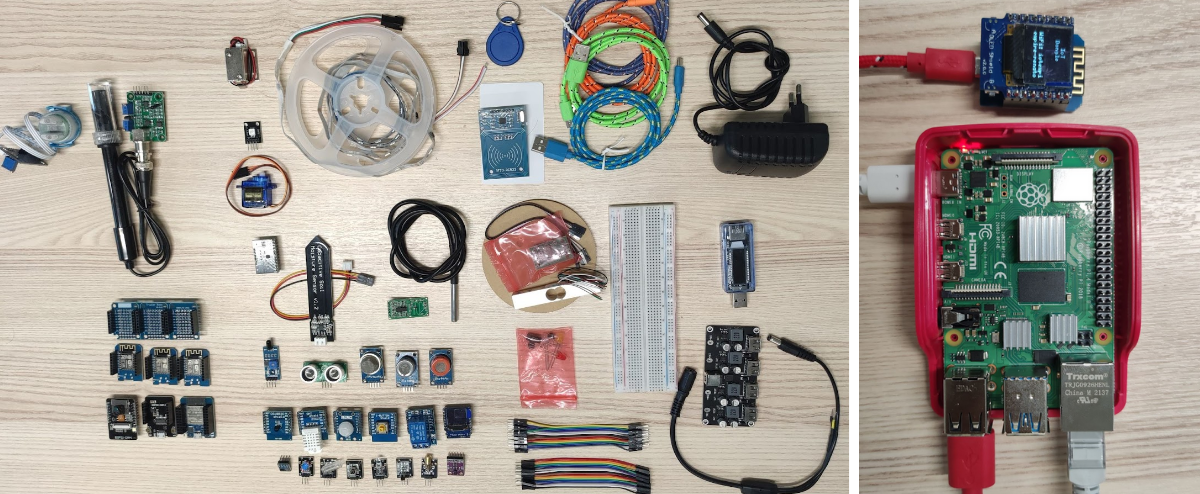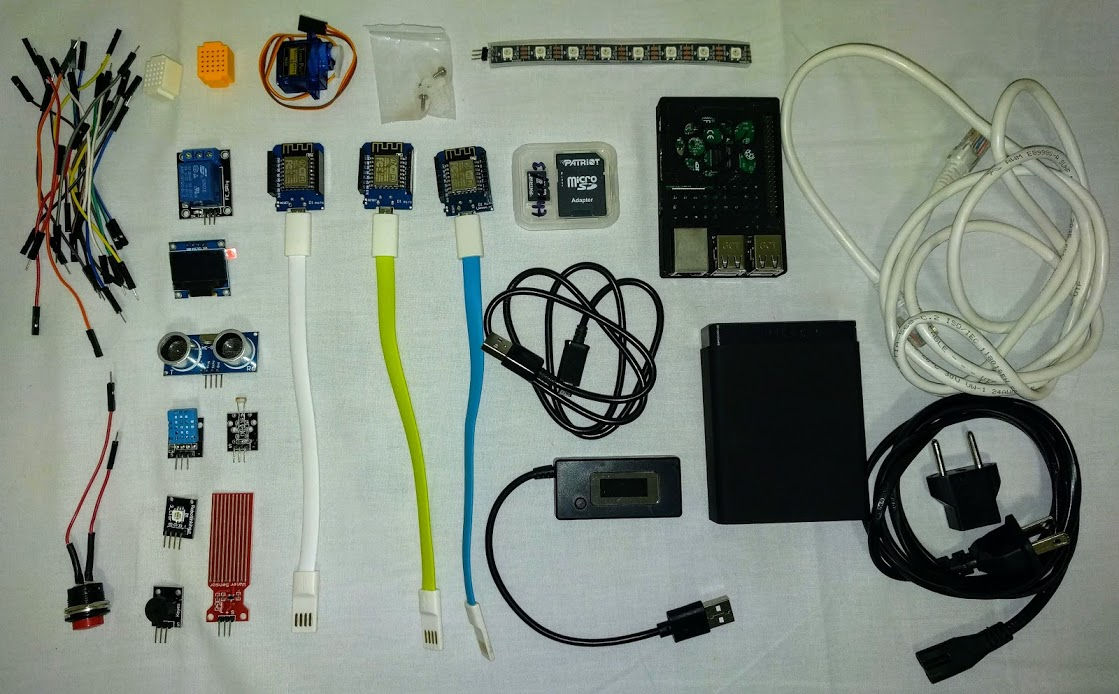Development Kits for the Internet of Things (IoT)
Current Kit

Current full IoT kit (and Raspberry Pi 4 gateway with IoTempower dongle) used at University of Tartu.
Gateway
The concept of a gateway is quite central for teaching IoT the IoTempower way. Therefore, each kit should contain some kind of gateway to allow an easy pre-installation of the IoTempower framework. If available for a decent cost this should be a Raspberry Pi 4 with at least 2 GB RAM, a good 3A USB-C power supply, and a fast (at least Class 10) 8GB SD-card. This can also be replaced with another single board computer, an old laptop or even Desktop. Old HPs or Lenovo Thinkpads with at least a dual core Intel i3, i5, or i7 have proven a very good reliable replacement. A Raspberry Pi (starting from Version 3) and some old laptops support running in Access-Point mode and can supply a local wireless network for a student team working with it. If the gateway does not support WiFi in accesspoint mode, a (small) WiFi router (best one that supports OpenWRT - this one is often available for a good price: https://www.gl-inet.com/products/gl-mt300n-v2/) should be also supplied.
Remark: An Android phone can also be configured as the IoT gateway. IoTempower installs well under Termux on Android. So, an old phone or one of the phones of the students that has a big enough data plan and can be put into Wireless Hotspot mode can also work well as a gateway.
Minimal Kit
The minimal kit should allow building the basic systems described in ulno's IoT introduction class until the Access Control project.
-
4-8 esp8266 MCUs (we like to use the Wemos D1 Mini) or esp32s (like the D1 Mini form factor MH Esp32 Mini Kit or esp32 s2 from Lolin) - we recommend 6 Wemos D1 Minis and two esp32s per kit (or when time moves on more esp32s and less esp8266)
THere should be also one decent USB data cable per MCU as well as a corresponding multi usb charger or a 12V to multiple USB charger board
1-2 small LCD displays (best with D1 Mini form factor and two buttons, OLED v2.0.0 with two buttons d1-mini shield/ mini screen/ monitor) if you want to simplify the setup - one of these can be mounted on one of the D1 minis and serve as an IoTempower dongle
Breadboard
Dupont jumper cables (at least 20 connector/connector, 10 plug/plug, 10 plug/connector)
Some 200 or 330 OHM resistors (also 1k, 2k, and 10k OHM would be good to have around)
a couple of one color LEDs
two push buttons (can also be the D1 Mini button shield)
Small 12V power supply with barrel connector
Y cable to split barrel connector in two, one side cut off to be connected to breadboard (can also be used to power a 12V multi usb charger converter board)
5V Relay
12V Solenoid drawer lock (can be other solenoid driven lock too)
RFID-RC522 card reader with 2 NFC tags
RGB LED (and if necessary the corresponding resistors)
Full Kit
The following components are optional and can also be available in smaller quantities as these should support the student's final project.
1-Button d1-mini shield
ADPS-9960 Color/Gesture/Distance Sensor
100uF capacitor for stabilizing ADPS-9960
VL53L0X laser distance sensor
MPR121 i2c capacitive touch multi sensor
OLED v2.0.0 with two buttons d1-mini shield/ mini screen/ monitor
DS22 temperature sensor d1-mini style
Mini PIR movement sensor - d1 mini style
Relay Switch d1-mini style
Water quality (turbidity) sensor
MQ2 sensor - smoke lpg butane gas
MQ3 sensor - alcohol/ethanol/smoke
MQ5 sensor - Methane/Natural Gas
MQ7 sensor - carbon monoxide
IR receiver LED (ky-022)
IR sender LED (ky-005)
TowerPro SG90 motor (360 mod)
TowerPro SG90 motor (real servo not 360 mod)
esp32 with cam module and dev board
RCWL-0516 capacitive/radar motion sensor
Laser (KY-008)
raindrop/soil humidity sensor (capacitive)
Flame sensor KEYES style
Knock/Shock Sensor (KY-031)
RCWL-1601 acoustic distance sensor
Real Dallas sealed Temperature sensors
Magnetic switch/hall sensor KEYES-style ky-003
WS8211 1m led strip
Small strong magnet 6x15
Load cell (max 1kg) with weighing plates and amplifier (hx711)
50 or 20g weight for calibration
wemos d1 mini triple attachment module
Water PH sensor amplifier board
Water PH sensor
ky-020 tilt sensor
buzzer keyes style
ds18b20 - d1 mini style
RGB Led keyes style
2V Micro DC Water Pump with 2 hoses
12V pump
Kit used pre 2018

The previous version of the development kit, I used in most of my classes until 2018.
As a bare minimum you should have at least one Raspberry Pi 3 with SD-Card and strong (2.5-3A) power supply, three (better 4) ESP8266 based development boards (like the Wemos D1 mini or NodeMCU), and several Arduino sensors (like button and temperature) and Arduino actors (leds, maybe rgb-LEDs or strips, and a relay or a small servo motor).
The depicted kit contains the following:
1x Raspberry Pi 3 with 3D-printed case
1x class 10 16GB SD-Card
3x Wemos D1 mini
3x short micro USB cable (for connecting Wemoses to power)
1x medium long micro USB cable (for connecting Pi to power)
1x multi USB power supply, power cable, and US/Europe adapter (with 2A per port) to power the Raspberry Pi 3 and the Wemos D1 Minis
1x ethernet cable to connect Raspberry Pi to Ethernet port to have Internet (can alternatively use a tethered connection from a phone plugged into USB)
1x USB power meter to see voltage and amperage
20x Dupont jumper cable (mostly male-male connectors, maybe some female-female connectors)
2x mini bread boards
1x simple contact button
1x small servo motor (i.e. Tower Pro SG90)
1x WS2812 LED-Strip with 8-10 LEDs
1x Relay
1x Small I2C Display (i.e. SSD1306)
1x distance sensor (i.e. HC-SR04)
1x temperature/humidity sensor (i.e. DHT11)
1x light resistant diode
1x RGB-LED
1x water/rain-Sensor
1x buzzer
I would love if any company could assemble a version of this kit for me, please contact me if you could - feel free to link to my IoT classes.